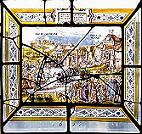Historians date the creation of the first stained-glass windows as we know them from the 9th century; at that time, and for several centuries to come, writing and reading was a privilege kept for a very small elite made up of Lords and particularly monks and copyists, whose lives seemed to be almost completely devoted to this occupation.
God creating stars, Church Ste Madeleine |
Saint Sebastian, Church Saint Jean |
Chaos, Church Ste Madeleine |
Stained-glass windows, just as stone or wood carvings found at the entrance of churches, are a means of transmitting, without using words, the lesson of the holy texts to the "uneducated" masses; it was the first vocation of the art of the glass-makers.
Histoire de la Vraie Croix, Church Saint Nizier, 1520 ; |
||
As the centuries passed, stained-glass windows served other purposes; the church or the cathedral was indeed a unique place of life in the Middle Ages, where the poorest rubbed shoulders with the richest, where all the medieval society gathered, to see or be seen. Stained-glass windows started telling stories, as in Sainte Madeleine's church, with the window about the life of Saint Louis; the Champagne Count Thibaud "Le Chansonnier" even appears there, paying tribute to his lord.
Many "sponsors" can now be found, who became characters in the windows they financed, either through their own figures or through the family coat-of-arms. This was very often the case with stained-glass windows of the 16th century. The rich families took an important and generous part in the rebuilding of the districts destroyed by the great fire of 1524; the same applied to the stained-glass windows in re-built churches. The Largentier, the Boucherat and the Muet families appear on the windows of Saint Pantaléon, Saint Jean and Sainte Madeleine. The stained-glass windows thus became a display of the social and economical power and wealth of these families.
Sometimes it was the gifts from craftsmen's guilds which helped the decoration of churches; just as the shoe-makers' association financed the sculpture of the "arrest of Saint Crepin and Saint Crépinien", which can be seen today in Saint Pantaléon; the guild of goldsmiths financed the beautiful window of the life of Saint Eloy, in Sainte Madeleine's church and there its coat-of-arms are displayed.
The technique of staining glass during the Middle Ages consisted of
dyeing glass "in the mass" by metallic oxides. This technique has been known
since the beginning of time. The use of coloured glass pieces assembled on a wooden or
plaster support brought about the creation of small mosaics, common during the 6th
century; thus this was the origin of stained-glass windows. Later, the glass pieces were
joined together by a lead network and supported by metal wires.
It was mainly at the start of the 12th century that stained-glass windows grew in number
in churches, and Gothic art accentuated this expansion. With the Renaissance, enamels
applied to the external face of the stained-glass gave a greater range of colours and made
it possible to mix colours similar to that seen in canvas paintings. Little by little, the
"grisaille" or enhanced fiery colour technique appeared (in the first half of
the 16th century): this technique made it possible to avoid cutting out as many pieces of
glass as there were colours, and resembled more nearly the drawing of an engraving, an
iconographic medium in rapid expansion at that time. The Troyes School of artists
distinguished themselves during the 16th and 17th century by preferring the coloured
stained-glass window to the grisaille, and by using from the very start of the 17th
century the technique of enamelled glass which makes it possible to work on white glass,
whilst using a broad range of colours for the scenes depicted.
Examples of "grisailles" in church Saint Pantaléon :







